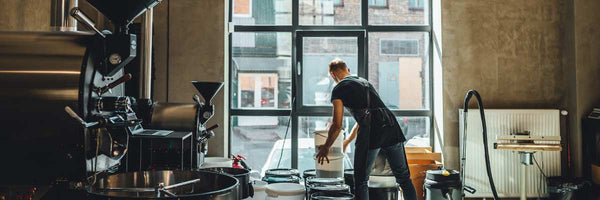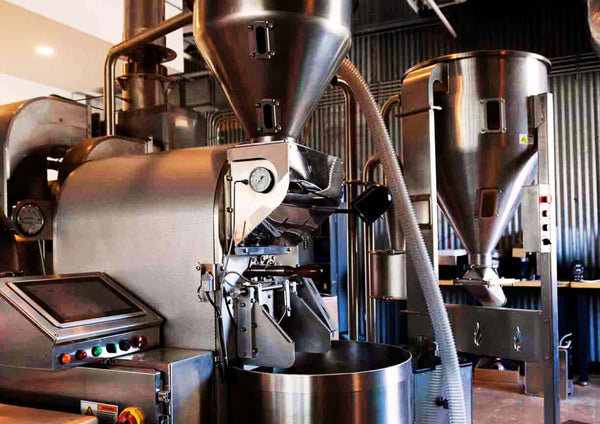
Preparing Your Space For New Roasting Equipment
By Howard Bryman
You’re planning on adding roasting equipment to your roastery, and a huge new (or new-to-you) roaster is finally on its way. Relief is in sight! This uptick in capacity will ease your production schedule and fling wide the floodgates to your coffee company's growth and expansion.
You couldn't be readier…but how's your facility?
New roasting equipment is never exactly "plug and play." With increased production comes the need for more green coffee storage, more ventilation, more emissions mitigation, and don't forget your new roaster's trusty sidekick: The afterburner.
Challenges can arise before the new machine even gets through the door. We checked in with some roastery design and installation specialists for insight into preparing your space for new roasting equipment or roasting gear upgrades, and the most common refrains we hear are: Don't make assumptions, and keep asking questions!
Consider The Ins & Outs
Johnny Cash might be able to smuggle a Cadillac home one piece at a time, but you might not be so lucky when it comes to your new roaster. Different brands of roasting equipment are assembled in different ways, and not all can be disassembled to the same extent.
So while it may seem like a silly question, you have to ask yourself: How sure are you that your new equipment will fit through the door?
Rick Davis, founder and CEO here at Coffee Equipment Pros, has more than a few stories of best laid plans nearly scuttled at the brink. One instance involved the installation of a 60-kilo Toper.
"After we measured and measured and measured, and talked and talked and talked, they were actually going to have to cut out the door and put a new jamb in to get the machine in," Davis told me. "As long as you are aware of that and have that expectation, everything is fine."
On another occasion, a roaster was being moved into a space where initial measurements seemed to indicate plenty of clearance for the machine. When this turned out not to be the case, a glass specialist was hustled in to deconstruct storefront windows and framing and then a forklift was rushed in to hoist the whole thing over an interior pony wall while rain clouds were gathering outside.
"Make sure you understand your roaster dims and what is removable," Davis cautioned. "It's a 'measure twice, cut once' type of thing. You have to make darn sure. You cannot assume anything."
Bigger Batches, More Greens, More Storage
Feeding that hefty new drum a steady diet of healthy greens means you'll need a lot more space to store those greens. When planning to add new roasting equipment, storage and space for more packaging and fulfillment will also be required.
Roastery consultant Mason Salisbury — co-founder of Luminous Coffee and all-around "professional coffee Swiss Army Knife" — considers scalability to be the most overlooked aspect in coffee roastery design.

"If you already have a pallet rack or two full of green, and you're going to add another roaster, maybe bigger, that means you're scaling to be bigger," Salisbury told me. "You're going to have double the green, double the cups — whatever you're doing for your business should be doubled."
Salisbury recommends spaces with higher ceilings to account not only for tall roasters but for taller racks and shelving. Also consider the space to maneuver around these racks and roasters.
"Stacking is always better than just spreading out everywhere, especially with green," said Salisbury. "To save on shipping, you're gonna want to store your pallets instead of having them shipped every week. Before you buy a roaster, figure out where you can position your roaster and if you can tear down walls and stuff like that to handle that scale."
Don't Go Up In Smoke
As your gaze extends past those majestic new racks, consider what rises even higher: Your rooftop vents, and the emissions coming from them. That's where the afterburner comes in.
Specific information on national and local emission standards may take some digging to clarify. Yet in many cases the threshold that matters even more is simply what level of aroma your neighbors will tolerate.
"They're gonna enjoy the smell of coffee for a couple of days. And then it's going to get annoying," Davis said of typical neighborly relations. "You’ll get a knock on your door because you're the one creating the problem. Officials might get involved, and then it gets ugly."
Pairing your roaster with an afterburner will add costs and complexity to your plans. You'll need to ensure your building's gas distribution supports the necessary flow requirements for the multiplied lines, and that your electrical panel can handle the draw, because while your roaster may seem like the hero of the story, it's her hot-headed sidekick that really saves the day.
Christian Longnecker, CMO of California-based Primo Roasting Equipment, sees afterburners as a necessary burden in a majority of cases.
"It's gonna mitigate about 95% of that smoke, and the smoke is the biggest complaint more than anything," Longnecker said. "Your neighbors will think, 'Wow, his building's on fire,' and just immediately call the fire department. In some areas you may have neighbors complain about the smell, and an afterburner mitigates that as well. As soon as you're going above that 12kg threshold, if you don't have an afterburner you're gonna run into these problems. It's inevitable."
No Dodgy Ducting
Longnecker also emphasized how ducting requirements evolve rapidly as roasters grow and afterburners appear. Existing systems will need to be revisited when adding new roasting equipment.
"Before you even do anything, you should really understand your county's rules and regulations, what the fire department wants you to have," said Longnecker. "I've had people use Home Depot ducting, and I've had other people with the same exact layout, the same exact system but in a more trafficked city area where the cost has gone from $1,500 to $15,000, just in ducting."
Honest and knowledgeable coffee professionals like Longnecker, Davis and Salisbury agree that for safety, for compliance, and for the quality of your coffee, proper ventilation and the right size afterburner are critical.
An HVAC contractor might gladly install a zig-zag from your machine to an existing roof portal to help you save on the cost of cutting a new hole in the roof. However, they also probably won't know or understand the requirements of your coffee operation.
"In the world of chimney and HVAC, three feet of horizontal equals 10 feet of vertical," said Davis. "Pay attention to those types of things, and ask the professionals. An HVAC contractor is not a roaster contractor."
If cooling tray exhaust enters into a roaster's hot air duct and flows at double or more the CFM when activated, Davis pointed out for another example, the cooler air becomes an obstacle to the required airflow through the chaff collector. This in turn may result in extreme back pressure, leading to smoke in the chaff collector, connecting ducting, and roaster.
"These are things that an HVAC guy wouldn't know," said Davis. "It's working with roaster professionals and asking a lot of the right questions that will save you from getting into an installation issue."
Anticipate to Accelerate
For a coffee-infused mixed metaphor, think: When adding roasting equipment, 20 grams of prevention is worth a container of cure.
The time to worry about afterburners, ducting and other safety and compliance measures is not when the complaints have already come in, not when officials are already at your door, and certainly not when smoke comes billowing from your stack or drum.
You also don't want to be hearing these things for the first time as your new equipment languishes in-house, awaiting installation, because as we often say around here: Roasters Need To Roast.
"Never buy equipment if you can't put it in the moment it arrives," Salisbury said. "The worst thing is spending money on equipment, waiting for the lead time, getting it, and then waiting longer. That's such a bad way of cash flow."
Oftentimes, city officials themselves won't know what to tell you when you start drilling into murky variables between ill-defined zones and settings and seemingly arbitrary weights and measures, from one agency to the next. The rules and requirements may seem almost impossible to learn, let alone follow. But learn them and follow them, you must.
"It's a fairly new industry for [many cities]," said Longnecker. "In the last two years, on the city and at a national level, they've gotten involved and they're making it fairly difficult for a lot of people. If you're in a very high-traffic, city area, you're jumping through hoops."
Shortcuts through the red tape don't exist, although the cascading costs can be mitigated with forethought, and it can all at least be fast-tracked with the help of experienced professionals that have seen it all before.
"I like to say this," Salisbury said. "Just do it the right way, and it doesn't matter where you are."






